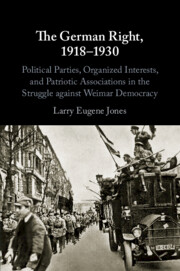 The German Right, 1918–1930
The German Right, 1918–1930 Book contents
- The German Right, 1918–1930
- The German Right, 1918–1930
- Copyright page
- Dedication
- Contents
- Figures
- Acknowledgments
- Abbreviations
- Introduction
- 1 Revolution and Realignment
- 2 Infrastructure of the German Right
- 3 Forging a Conservative Synthesis
- 4 Growth and Consolidation
- 5 The Radical Right
- 6 1923 – A Missed Opportunity?
- 7 From Triumph to Schism
- 8 Stabilization from the Right?
- 9 Paladins of the Right
- 10 A Resurgent Nationalism
- 11 The Road Back to Power
- 12 The Burden of Responsibility
- 13 From Defeat to Crisis
- 14 Reverberations and Realignment
- 15 The Chimera of Right-Wing Unity
- 16 Schism and Fragmentation
- 17 The Brüning Gambit
- 18 The September Earthquake
- Epilogue
- Select Bibliography
- Index
6 - 1923 – A Missed Opportunity?
Published online by Cambridge University Press: 21 March 2020
- The German Right, 1918–1930
- The German Right, 1918–1930
- Copyright page
- Dedication
- Contents
- Figures
- Acknowledgments
- Abbreviations
- Introduction
- 1 Revolution and Realignment
- 2 Infrastructure of the German Right
- 3 Forging a Conservative Synthesis
- 4 Growth and Consolidation
- 5 The Radical Right
- 6 1923 – A Missed Opportunity?
- 7 From Triumph to Schism
- 8 Stabilization from the Right?
- 9 Paladins of the Right
- 10 A Resurgent Nationalism
- 11 The Road Back to Power
- 12 The Burden of Responsibility
- 13 From Defeat to Crisis
- 14 Reverberations and Realignment
- 15 The Chimera of Right-Wing Unity
- 16 Schism and Fragmentation
- 17 The Brüning Gambit
- 18 The September Earthquake
- Epilogue
- Select Bibliography
- Index
Summary
Chapter 6 deals with the crisis year of 1923 and examines the German Right’s response to the hyperinflation of 1922–23, the Franco-Belgian occupation of the Ruhr, the increasingly palpable fear of Bolshevism, and threat of Bavaria’s secession from the Reich. After a discussion of the DNVP’s relationship to the Cuno government that assumed office in November 1922, the chapter takes a particularly close look at its opposition to the Stresemann cabinet that assumed power at the height of the crisis in August 1923. Following the termination of passive resistance in the Ruhr, many DNVP leaders began to embrace the idea of a “national dictatorship” under the tutelage of the army commander-in-chief Hans von Seeckt as the only way out of the crisis in which Germany found itself. But movement in this direction was cut short not only by Seeckt’s ambivalence but more importantly by Hitler’s abortive “Beer Hall Putsch” in Munich. As the Stresemann government moved to consolidate its position in the aftermath of the putsch, any chance of replacing the Weimar Republic with a more authoritarian system of government had vanished.
Keywords
- Type
- Chapter
- Information
- The German Right, 1918–1930Political Parties, Organized Interests, and Patriotic Associations in the Struggle against Weimar Democracy, pp. 176 - 206Publisher: Cambridge University PressPrint publication year: 2020
